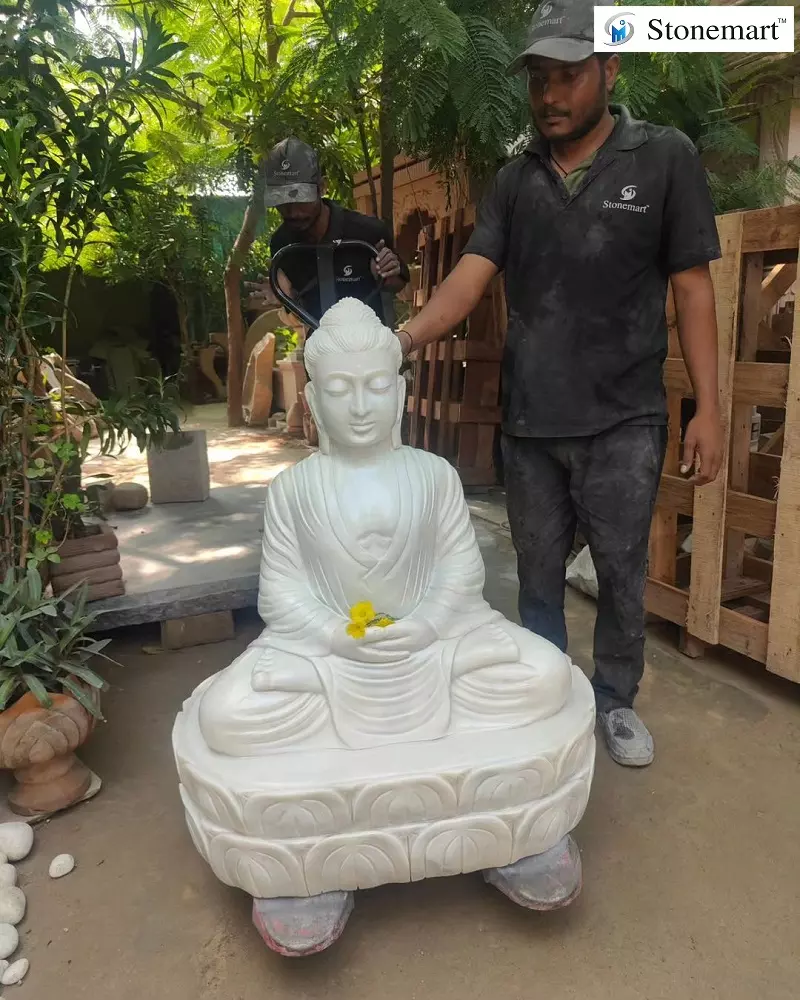What is the Difference Between a Dhyana Mudra and an Abhaya Mudra Buddha Statue?

When we look at the Buddha statues in different mudras, most of us wonder why one specific mudra is different from the other. Here in this new series, we are going to shed some light on the differences that are conspicuous between different mudras of the Buddha.
Here, we are going to begin classifying the differences between two of the most popular mudras of the Buddha. One is dhyana mudra Buddha and the other is abhaya mudra Buddha. The Buddhas personifying the mudras can be found in the form of natural stone Buddha statues that can be placed at different landscapes including home and garden.
Let us get a brief on the differences between dhyana mudra Buddha sculpture and abhay mudra Buddha sculpture with respect to their historical origin, how the Buddha idols look in these mudras, how their presence is going to influence your life with positive Vastu and Feng shui and not to mention, how and where they should actually be placed.

MUST READ: How to Choose the Right Buddha Statue for Home?
| Criterion | Dhyana Mudra Buddha | Abhaya Mudra Buddha |
|---|---|---|
| Origin | It is the form of the Buddha known as Amitābha, the fourth dhyani Buddha. It is a meditating Buddha before attaining the enlightenment by focusing on dharma to attain spiritual perfection. | It is the form of the Buddha known as Amoghasiddhi, the fifth dhyani Buddha. He took this mudra to overcome fear and jealousy after his cousin Devdutta plotted to kill him through a mad elephant named Nalagiri. This fearless and blessing mudra of the Buddha granted the elephant his refuge and assuaged his rage nature. |
| Appearance | The body of the Buddha appears like a triangle to represent the three jewels of Buddhism, namely the Buddha, the Dharma and the Sangha. The palms of both the hands are placed upon the lap facing upwards with the fingers extended. The eyes of the Buddha remain closed focusing on in-depth clarity of thought. | Used in both standing Buddha statue and sitting Buddha statue with the palm of the right hand extended in a blessing mudra with all the fingers outstretched. The palm is slightly cupped and faces the viewer. |
| Vastu and Feng-Shui Effects | Beneficial for spreading a positive aura of inner peace, self awareness and relaxing energy. | The raised right hand safeguards the bearer and his or her premises from negative energies, evil spirits and misfortune. |
| Placement | Meditating Buddha statue is placed in the meditation room, living room, as well as in the corner facing East to stimulate the energy of the corner. | This blessing Buddha statue is placed at the entrance facing East to make the person fearless and confidence to face any kind of situation in life. |
MUST READ: 10 Buddha Mudras, Hand Gestures With Meaning

Now, as one got familiar with the difference between a mediating Buddha and a fearless Buddha, you can buy one for your home according to your prerequisites. Always go for natural stone Buddha idols only as the Buddhas made from other materials contain impurities and are not considered good for placement at home. You can look for 2 feet Buddha statue, 3 feet Buddha statue, 4 feet Buddha statue, 5 feet Buddha statue, and above.
For exclusive black marble Buddha statues, white marble Buddha statues, sandstone Buddha statues and Buddha fountains, reach Buddha sculpture and transform your existence with the blessings of the Buddha Ji.
